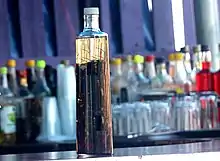Akpeteshie
Akpeteshie is the national spirit of Ghana, produced by distilling palm wine or sugar cane. It is the most popular alcoholic drink in Ghana, and goes by many names inlucing apio, ogoglo, ogogoro (Ogog') , VC10, Kill Me Quick, Efie Nipa, Kele, Kumepreko, Anferewoase, Apiatiti, Home Boy, Nana Drobo, One Touch among others.[1] Ghanaian moonshine is referred to as akpeteshie.

History and origins
Before the advent of European colonization of what is today Ghana, the Anlo brewed a local spirit also known as "kpótomenui," meaning "something hidden in a coconut mat fence."[2]
With British colonization of what became known as the Gold Coast, such local brewing was outlawed in the early 1930s. According to a 1996 interview with S.S. Dotse about his life under British colonial rule: "Our contention was that the drink the white man brought is the same as ours. The white men's contention was that ours was too strong...Before the white men came we were using akpeteshie. But when they came they banned it, probably because they wanted to make sales on their own liquor. And so we were calling it kpótomenui. When you had a visitor whom you knew very well, then you ordered that kpótomenui be brought. This is akpeteshie, but it was never referred to by name."[2]
The name "akpeteshie" was given to the drink with its prohibition: the word comes from the Ga language (ape te shie, the act of hiding) spoken in greater Accra and means they are hiding, referring to the secretive way in which non-European inhabitants were forced to consume the beverage.[3] Despite being outlawed, Illicit spirits remained commonplace, with reports that even schoolboys were able to easily obtain akpeteshie through the 1930s. Demand for akpeteshie and the profits to be made from its sale was enough to encourage the spread of sugar cane cultivation in the Anlo region of Ghana.[4]
Distillation was legalized with decolonization and Ghanaian independence. The first factory was established in the Volta Region, taking advantage of the area's supply of sugar cane plantations.[4]
Brewing
Akpeteshie is distilled from palm wine or sugarcane juice.[5] This sweetened liquid or wine is first fermented in a large barrels, sometimes with the help of yeast.[6] After this first stage of fermentation, fires are built under the barrels in order to bring the liquid to a boil and pass the resulting vapor through a copper pipe within cooling barrels, where it condenses and drips into sieved jars. The boiled juice then undergoes a distillation.[7] The resulting spirit is between 40 and 50% alcohol by volume.[8]
Packaging and consumption
Akpeteshie is not professionally bottled or sealed, but instead poured into unlabeled used bottles. The spirit can be bought wholesale from a brewer or by the glass at boutiques and bars. Although not professionally advertised, the drink is very popular. This is partially due to its price, which is lower than that of other professionally bottled or imported drinks. Its relative cheapness makes it a drink associated more with the poor, but even those who can afford better quality are said to consume the spirit in secret.[7]
The potency of the liquor heavily affects the bodily senses, providing a feeling likened to that of a knockout punch. Practiced drinkers can be seen acknowledging receipt by blowing out air or pounding their chest.[7]
Health
Medical practitioners have been critical of the drink's high concentration of alcohol, particularly the damage it can cause the liver and the risk of alcoholism.[8]
Methanol poisoning incident
66 people in Rivers State died over a few weeks that started in April 2015 due to methanol contaminated ogogoro.[9][10][11]
References
- User (2019-06-18). "'Akpeteshie': the local gin which has served presidents, chiefs and commoners". Home | Goldstreet Business. Retrieved 2019-11-07.
- Akyeampong, Emmanuel Kwaku (2001). Between the Sea & the Lagoon: An Eco-social History of the Anlo of Southeastern Ghana : C. 1850 to Recent Times. James Curry Publishers. p. 154.
- Peele, Stanton (1999). Alcohol and Pleasure: A Health Perspective. Psychology Press. p. 123.
- Akyeampong, Emmanuel Kwaku (2001). Between the Sea & the Lagoon: An Eco-social History of the Anlo of Southeastern Ghana : C. 1850 to Recent Times. James Curry Publishers. p. 155.
- Peele, Stanton (1999). Alcohol and Pleasure: A Health Perspective. Psychology Press. p. 123. ISBN 9781583910153.
- Chernoff, John M. (2005). Exchange is Not Robbery: More Stories of an African Bar Girl. Chicago: University of Chicago Press. p. 194.
- GBC News. "Expert Warns Against "Akpeteshie' Consumption". Archived from the original on 13 December 2013. Retrieved 8 February 2013.
- Luginaaha, Isaac; Crescentia Dakubob (2003). "Consumption and impacts of local brewed alcohol (akpeteshie) in the Upper West Region of Ghana: a public health tragedy". Social Science & Medicine. 57 (9): 1747–1760. doi:10.1016/s0277-9536(03)00014-5. PMID 12948582.
- "66 Die Of Ogogoro In Rivers State".
- Winsor, Morgan (21 April 2015). "Nigeria's Mysterious Epidemic Linked To Contaminated Alcohol And Methanol Poisoning, Not Ebola". International Business Times.
- "Nigeria: NAFDAC - Methanol Responsible for 'Ogogoro' Deaths in Rivers".
